(VOVworld) - 30km from the center of Hanoi in the outskirt district of Thanh Oai lies Tri Lễ village, a famous hamlet that makes the iconic Vietnamese traditional palm leaf hats such as Nón or conical hats, Quai Thao or flat palm hats, and Thúng. The brilliant mid-summer sun these days provides the perfect condition to dry out the palm leaves that Tri Lễ residents hang along the road which leads to the village.
From generations making hats…
Arriving in Tri Lễ, visitors can immediately recognize the familiar atmosphere of a village in Northern Vietnam. In front of the village stands an over 80-year old gate with some flaking paintwork. Take a quick glimpse in any open door, the grounds seem to be dyed white by the white color of dried palm leaf. Under the shady roof, old women and some children were busy sewing hats – an iconic accessory to Vietnamese people over generations.
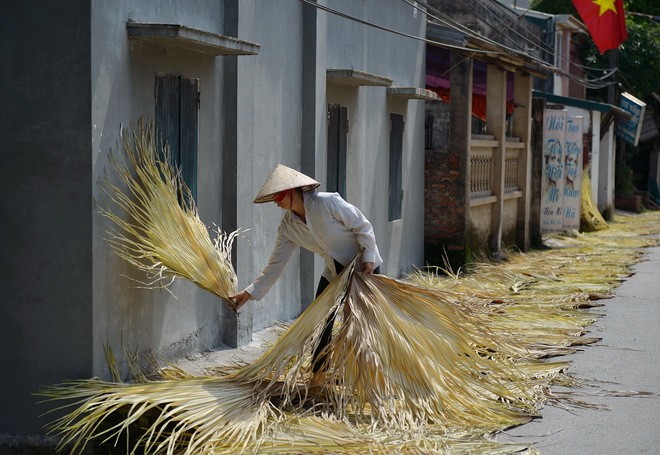 |
|
The brilliant mid-summer sun these days provides the perfect condition to dry out the palm leaves that Tri Lễ residents hang along the road which leads to Tri Lễ village (Photo: Nguyen Minh Son)
|
Tri Lễ village has a population of around 4,000 people, three-quarters of whom already know how to make palm leaves. The simple and clean production makes hat craftsmanship most suitable to farmers with little farm. Nghiêm Phú Luận from one of the oldest families producing hats in the village told me about the traditions of his people: “Our village has been making hats for over 400 years. We grew up watching our father, grandfather and other elderly working with hats. We just inherited the craftsmanship and then elaborated it. Our hats are still 100% handmade. Other villages can use machine to split the bamboo and thresher the rattan to make other palm leaf furniture and products. We don’t. There has not been any machine that can support the hat production in Tri Lễ though many people have tried”.
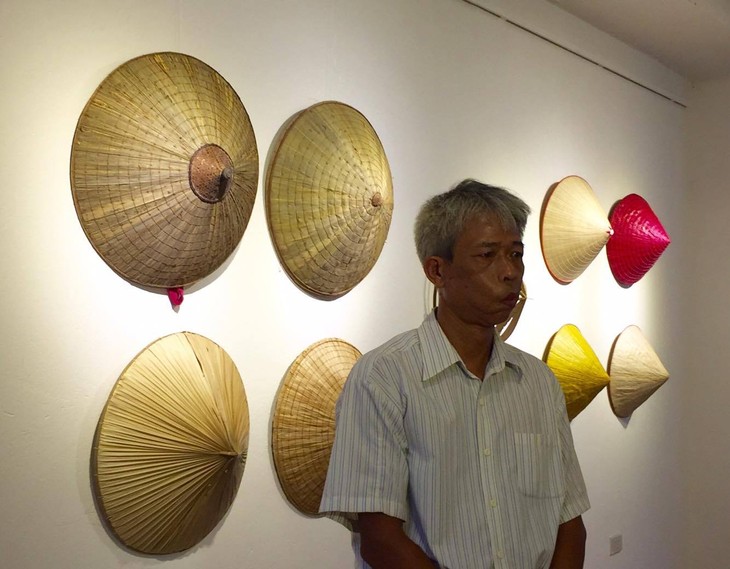 |
Craftsman Nghiêm Phú Luận is ffrom one of the oldest families producing hats in the village (Photo: VOV/Dieu Ha)
|
Tri Lễ is the most famous for making conical hats. Like any other palm leaf hat, the hat-maker first needs to create a wooden frame to firmly situate several bent bamboo rings, which differ in size. This may be the most complicated and time-consuming step of the whole hat-making process. Mrs. Vũ Thị Hồng is over 80 years old and has been doing this work since the age of 7. She said: “A beautiful hat depends a lot on how you bend the bamboo strands into round rings. If the rings are perfect and steady, you can easily sew the leaves. But if they are done carelessly, the hat will turn ugly. Therefore, not everyone but those with skills can do the work. Moreover, the bamboo must grow naturally in the forest and be straight and strong. You see, we even have a layer of bamboo strands between the outside and inside leaf coating to keep the conical hat firm and durable”.
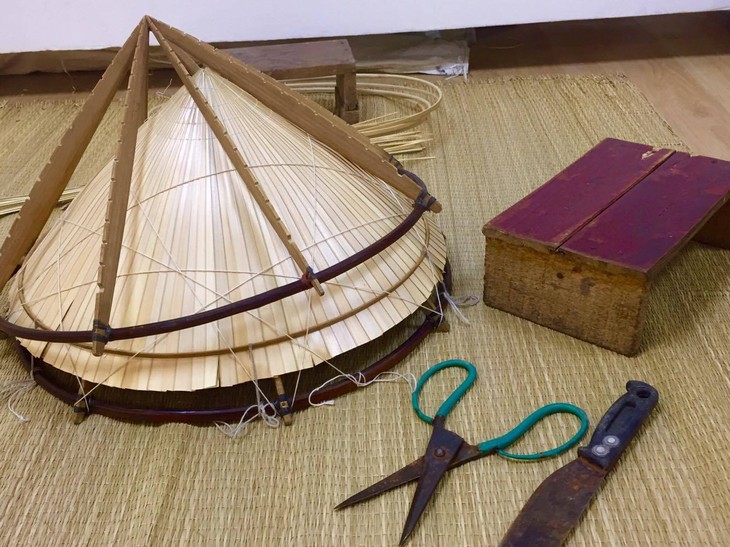 |
| Making a firm wooden frame for situating some bent bamboo rings may be the most complicated and time-consuming step of the whole hat-making process (Photo: VOV/Dieu Ha) |
After a strong frame is completed, leaves will be attached to it by threads. Tri Lễ’s conical hats are famous for having two layers of leaves. Craftsmen must be very skillful to make the two layers very thin. Mrs. Hong continued: “The leaves are still freshly green when we buy them. Then, we dry them until they turn white, usually after 15 days or more. After that, we use the heat of the kitchen, together with a pack of hot clothes to iron the leaves many, many times until they are completely “cooked”. It means the leaves are now flexible, smooth and easy to sew”.
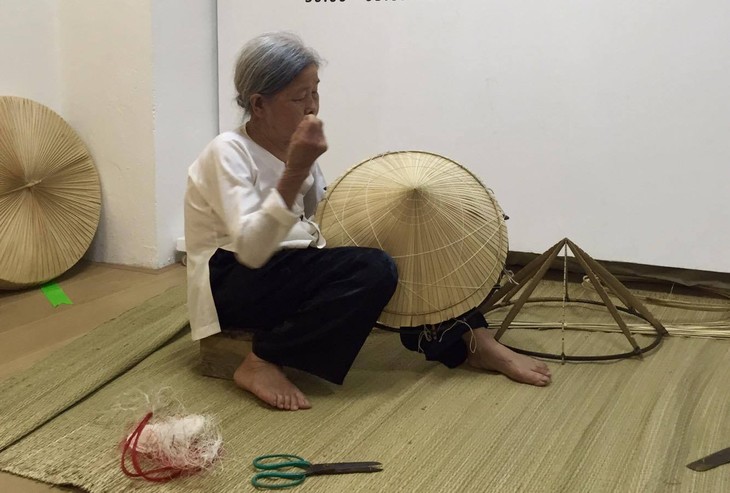 |
Mrs. Vũ Thị Hồng is attaching palm leaves to the frame by threads (Photo: VOV/Dieu Ha)
|
Tri Lễ village does not grow palm trees but buys the materials from other provinces. Nghiêm Phú Luận said: “We mostly use the young leaves of palm trees to make hats. Other leaves can be used are from a kind of rhapi trees, which only grow in the Central Hà Tĩnh and Quảng Bình provinces. In the past, hats were made from sugarcane or reed leaves. Later, we figured out that young palm leaves were the best materials as they are light, cool and mostly waterproof”.
Apart from the iconic conical hats, Tri Lễ village is also famous for preserving and restoring other Vietnamese traditional hats such as Quai Thao, Xuân Kiều, and Thúng. To artist Nguyễn Huy An, this makes Tri Lễ one of the best places to learn about the lives and craftsmanships of the people in Northern Vietnam. He said: “It’s amazing to visit Tri Lễ village, where I can learn about the history and the ups and downs of Vietnamese traditional hats. For example the Ba Tầm hats at some point in the past completely disappeared; no one used or made them. But people in Tri Lễ restored and made them alive again. Each traditional product tells history in a very unique way, unlike in the pages of a text book”.
…to the struggle to survive
Sold at cheap price, each hat can only earn to its makers as little as 8,000VND, or 40 US cents. Thus most residents here consider hat making a part-time job, which they can do between farming sessions. However, as the market and the buyers’ preferences change, Tri Lễ hat products now face many challenges to survive. Mr. Luận said: “Talking about the market, our hats are still mostly sold inside Vietnam. Since the 1990s when the market was opened, Tri Lễ hats were introduced to the international market. However, it does not change the fact that more and more young people are giving up the job, because of its little income and time-consumption. In my village nowadays, only those who cannot find any other job outside, old people and children continue making hats. With our limited workforce, we cannot fully supply the needs of the market”.
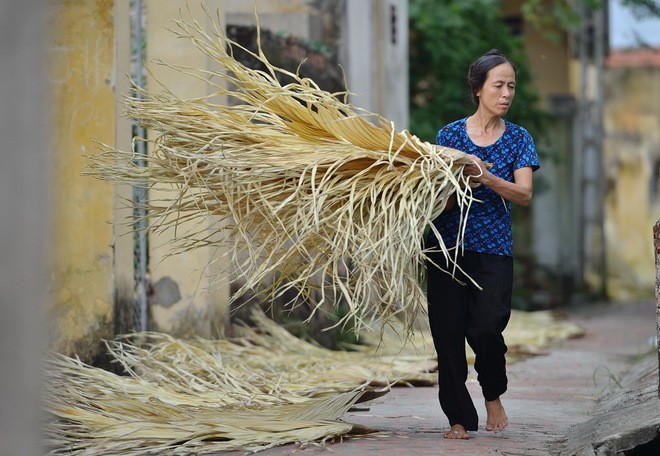 |
In Tri Lễ village nowadays, only those who cannot find any other job outside, old people and children continue making hats (Photo: Nguyen Minh Son)
|
Mr. Luận believes it is purely passion and love that helps this traditional craftsmanship alive and keeps Tri Lễ’s people making hats. But to keep up with the market, the remaining workers still try to innovate and transform the hats into more modern styles. Mr. Luận continued: “During the history of our village, we always innovate the traditional palm leaf hats. The first one comes up with an idea, and then each maker contributes a little: the shape, the frames and the materials. Take a look at this cap for example. Vietnamese people did not wear caps in the past. This is Western and only came to be known to us since we opened the market. We also had a type of hat called Lâm Xung, which we designed after a famous Chinese hero. It’s one of the most popular products made by my family”.
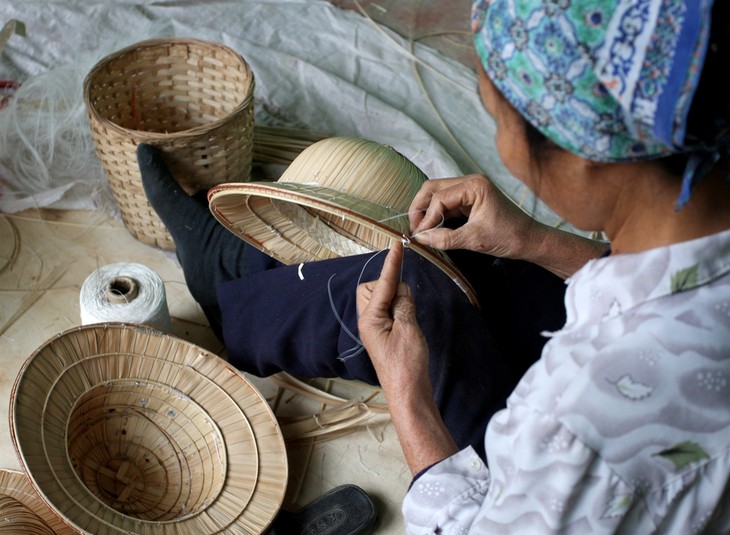 |
| A women is finishing a Lâm Xung hat, which was designed after a Chinese hero and is one of the most popular products made by Tri Lễ's people (Photo: Hoai An) |
Artist Nguyễn Huy An also showed big concerns about the future of this particular tradition. He said: “It’s hard to believe that the hat craftsmanship in Tri Lễ village can survive strongly in the future. Its survival will mostly depend on those who actually care, such as artists, fashion designers or moviemakers, not on those who make them. Craftsmen need to find a better way to make a living. However, what I worry the most, not only in Tri Lễ village but also in many other traditional craft villages, is the designs are decided on the orders of foreign companies who import those products. This can kill the authentic and original characters of the hats if local authorities do not act quickly in response”.
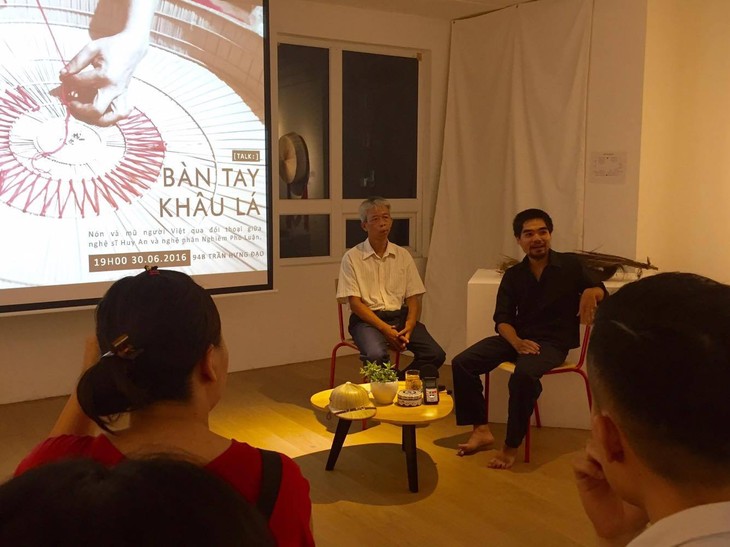 |
| Craftsman Nghiêm Phú Luận was at a recent exhibitions and workshops on Tri Lễ's craftsmanship and products, which help preserving the hat-making tradition in his village. (Photo: VOV/Dieu Ha)
|
The conical and other palm leaf hats are unique to the Vietnamese people and have been in use for centuries. Realizing the need to preserve hat production in Tri Lễ, Six Space platform, a group of multidisciplinary artists and art researchers, recently opened an exhibition and workshop in Central Hanoi to introduce Tri Lễ’s products to a wider audience and art lovers. Artist Lê Giang, head of the project, said: “We chose to hold an exhibition of conical hats because this is one of the most significant features of the Vietnamese people, especially in the past. But the craft is gradually fading and not many people really know about the history and the development of these hats. Our project aims to discuss the internal and external factors that influence the aesthetics, creative process and the production of Tri Lễ villagers, and how to preserve and innovate the art”.
In these summer days, the children in Tri Lễ village, who do not have to go to school, stay at home to help grandmothers and mothers making palm leaf hats. The laughing and giggling melt away the quietness of the village. Visitors go to Tri Lễ not only to learn about its traditions or to buy souvenir hats, but also to enjoy fresh air, the beautiful landscape and the friendly people.